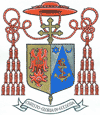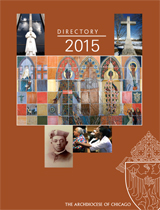
The Cardinal’s Column
Francis Cardinal George, O.M.I.
January 18, 2009
St. Paul in America
Cardinal George's Schedule
- Jan. 18-21: Meeting for the Council of the Synod of Bishops, Rome, Italy
- Jan. 21-22: March for Life, Washington, D.C.
- Jan. 21: 7 p.m., National Vigil Mass for Life, Basilica of the Shrine of the Immaculate Conception, Washington, D.C.
- Jan. 22: 10 a.m., Youth Mass, Verizon Center, Washington, D.C.
- Jan. 23-27: Vacation
- Jan. 28: 2 p.m., Installation Mass for Archbishop Allen Vigneron, Detroit
- Jan. 31: 9:30 a.m., cardinal’s visit for evangelization, St. Mary, Lake Forest

Cardinal's Appointments
December 15, 2008
His Eminence, Francis Cardinal George announces the following appointments:
Director
Rev. Dusan Hladik, from resident of the Czech Catholic Mission, Cicero, to be the director of the same, effective immediately.
“We give thanks to God always for you all…” (1 Thes 1:2). St. Paul’s first letter to the Church in Thessalonika is most probably the earliest of his letters in the New Testament. It was written around the year 50 A.D. The letter begins with a salutation: “Grace to you and peace,” (I Thes 1:1) and ends by turning the salutation into a prayer, “The grace of Our Lord Jesus Christ be with you” (I Thes 5:28). St. Paul is called the Doctor of Grace, because God’s life in us, called grace and won for us by Christ, was at the center of his life, his teaching and his ministry.
This is the Year of St. Paul, from June 29, 2008, to June 29, 2009. Jan. 25 is the Feast of the Conversion of St. Paul. Jan. 22 is the 10th anniversary of the publication of The Church in America, the result of the deliberations of many bishops of this continent who gathered with Pope John Paul II to reflect on the mission of the church at the beginning of the third millennium. St. Paul’s life and letters were a prism used ten years ago to reflect on discipleship in North and South America.
St. Paul the convert
The third chapter of the document, The Church in America, speaks of conversion to Christ in his body, the church. Paul’s life turned upside down and inside out when he encountered the risen Christ on the road from Jerusalem to Damascus. Christ told Paul to stop persecuting the church and called him to continual growth in holiness of life. The New Testament uses the word metanoia, a change of mentality, to speak of conversion. It doesn’t mean just a change of mind but, rather, a change of life, a way of acting in the light of the Gospel. St. Paul speaks of “the faith that works through love” (Gal 5:6). Conversion prepares one to know God’s ways among us, to pray with God’s inspired word, to receive the sacraments of penance and the Eucharist and to worship God in spirit and truth. Conversion leads to ecclesial communion in Christ, who is the head of his body, the church; conversion moves to social solidarity with all whom Christ loves, especially with the poor and needy. Conversion brings new life, a life that removes any division between faith and works in daily life, so that Christians give testimony to Christ in all circumstances of life.
St. Paul the preacher
Paul’s encounter with the Lord and his consequent conversion fit God’s plan for the conversion of the Gentile nations (Gal 1:16 and The Church in America, 8). Paul’s preaching, adapted to the various cities to which he traveled, remains the model for proclaiming the Gospel in every age. His preaching mission included the frequent praise of God for the gift of our forgiveness and salvation, arduous physical work so as not to burden the peoples he served and the testimony of his personal example of life “in Christ.” (1 Thes 2:11-12)
St. Paul the educator
To “put on the mind of Christ,” St. Paul not only taught the truths of faith; he also taught people to pray and to rely on the power of the Holy Spirit to pray effectively (1 Cor 12:13 and The Church in America, 29). Paul was a mystic, and he invited all to contemplate the mysteries revealed in Christ and enter into a way of knowing open to all who live in the Spirit. This issue of the Catholic New World is dedicated to Catholic education; how to pray is part of that schooling. The church has used schools and catechetical programs and other ministries to teach here and throughout the world who Christ truly is. The purpose of all this is to help people live with dignity and generosity in this life and to become saints forever. I believe that St. Paul would be proud of our Catholic schools and our catechetical programs!
St. Paul the steward
At the end of many of his letters, Paul begged help for the poor and for churches far from the people to whom he was writing (Phil 4:10-20). “The Church in America must incarnate in her pastoral initiatives the solidarity of the universal church towards the poor and the outcast of every kind. Her attitude needs to be one of assistance, promotion, liberation and fraternal openness” (The Church in America, No. 58). Loving the poor is a way of encountering the risen Lord. I believe that, if Paul were traveling in Cook and Lake Counties today, he would give to the Annual Catholic Appeal that begins next month!
St. Paul teaches that all is grace, which means that all is gift. When we receive a gift, we say thanks. When we receive the gift of God’s grace, our entire lives should express our gratitude to God. “Therefore, my beloved, as you have always obeyed, so now, not only as in my presence but much more in my absence, work out your own salvation with fear and trembling; for God is at work in you, both to will and to work for his good pleasure” (Phil 1:12)
With St. Paul, I pray that God’s grace and peace will be with all of you and those you love.
Sincerely yours in Christ,
Francis Cardinal George, OMI
Archbishop of Chicago
 Catholic
New World - Newspaper for the Archdiocese of Chicago
Catholic
New World - Newspaper for the Archdiocese of Chicago Archdiocese of Chicago Directory
Archdiocese of Chicago Directory Oficjalne wydawnictwo Archidiecezji Chicago w języku polskim
Oficjalne wydawnictwo Archidiecezji Chicago w języku polskim